
 |
|
 |

 |
|
 |
| 10-23-2008, 11:59 PM | #23 |
|
Captain
    80
Rep 961
Posts |
I was curious about the function of the hood vent so I tied a piece of string to it and went to a track day.
As others have posted, it is a vent (the string stands up and waves around) until you're at full throttle and high speed - then the vent becomes an intake and sucks air into the engine (the string collapsed against the mesh grill). It doesn't need a flap - it works fine the way it is. |
|
Appreciate
0
|
| 10-24-2008, 06:48 AM | #24 |
|
Major General
  
295
Rep 6,005
Posts |
My theory is that it's function is not to perform like a vent it just so happens air comes out of it when not at full throttle. It is strictly there to provide enough air intake at full throttle. I also think that BMW did enough research to provide enough intakes in this car for air to get in. Therefore adding more intake spots or scoops or anything similar is a waste. You're going to get to a major restriction at the air filter and then through the rest of the intake into the cylinders. If the car wasn't getting all the air it needed don't you think BMW would've just put a bigger hole in the hood?? Does anyone really think BMW just released a ///M car that is starved of air? I'm willing to bet the only way you will get more air into the combustion chamber is to add some sort of FI that physically squeezes/pushes more air not only through the filter but all the way into the cylinders.
I have no evidence to support my theory, but just find it very strange that with all the R&D that goes into these cars that they would somehow starve it of air.
__________________
 |
|
Appreciate
0
|
| 10-24-2008, 07:15 AM | #25 | |
|
Banned

79
Rep 2,244
Posts |
Quote:
Why didn't BMW run more advanced timing for more power? Why didn't BMW gear the car shorter? There are concessions that need to made, on any car. They made the decisions that they felt worked best for the car in every market. A design can be refined and enhanced further. I wonder if BMW ever thought E46 M3's would be hitting 1000 wheel hp? BMW releases intake improvements with their own performance products. Even they admit their designs can be made more efficient once solely going for the goal of power. Your talk about why BMW didn't do this or that on the M cars, the scoops have already shown, with lots of data to support it, gains on modern M vehicles. The scoops make use of the efficient factory design, this is not a BMW flaw. BMW could not block the radiator as the scoops do. |
|
|
Appreciate
0
|
| 10-24-2008, 07:49 AM | #26 | |
|
Major General
  
295
Rep 6,005
Posts |
Quote:
As I said, I have no data to back this up. I'm also not claiming to be right, it's just a thought I have on the subject of more air in this engine. Just posted it up here to see if anyone else thought it's a little strange BMW would've missed this "simple" improvement on the car.
__________________
 |
|
|
Appreciate
0
|
| 10-24-2008, 04:58 PM | #27 | |
|
Banned

79
Rep 2,244
Posts |
Quote:
|
|
|
Appreciate
0
|
| 10-24-2008, 11:41 PM | #28 | |
|
NASA/PDA Instructor

24
Rep 284
Posts |
Quote:
Yep...the main/largest source of air is the lower inlet, the one where the driver's side foglight would be. That location, with it's much straighter pathway to the airbox and it's location of a very high pressure area, would be more than sufficient for most motors. The radiator inlet, very restricted in size and bends, and the top hood inlet are, in essence, a very cold-air intake. And I'm sure there is sufficient air for the motor. My thoughts are that the "ram-effect" that is so prevalent on high performance cars, bikes, etc....could be improved with the flapper. It would ram when it could and open if the motor needed it. So you'd get, in theory, the 1-2mpg increase that the other closed-box cars enjoy....and a pressurized intake. JAJ, Do you think the string colapsed on the mesh as a result of the air, that was passing over the hood at a high speed/pressure, because it was just "blown-over"...or does the vent actually enjoy a high-enough pressure from air passing over the vent that it becomes a legitimate intake source? Or that the motor actually needs the vent as a source of air and creates a vacuum in the box? A pressure sensor...even a decent boost gauge...would be able to show if there was positive or low pressure in the box. Yet another thing I need to do.....  Be good, TomK
__________________
 "Arcadian, I've fought countless times, yet I've never met an adversary who could offer me what we Spartans call "A Beautiful Death." I can only hope, with all the world's warriors gathered against us, there might be one down there who's up to the task."Μολὼν λαβέ!! |
|
|
Appreciate
0
|
| 10-25-2008, 01:11 AM | #29 | |
|
Captain
    80
Rep 961
Posts |
Quote:
My conclusion is that at full throttle the opening provides extra air for the engine, and at part throttle it keeps cool air coming in and warm air blowing out to prevent heat soak. You could put a flap on it, but then on a hot day in traffic it would cut power because the intake air would be super hot. |
|
|
Appreciate
0
|
| 10-25-2008, 04:14 AM | #30 |
|
yodog

201
Rep 5,024
Posts |
^ Pretty cool.
__________________
 2009 E92 M3 | Alpine White | Black Extended | Advan RS | Turner Test Pipes | Dinan Axle-Back | OETuning | Eibach Springs | UUC SSK | VRS Front Lip | VRS Type I Diffuser | Matte Black | RPi Scoops | MS Filter | Yokohama AD08 | F1 Pinnacle Special Thanks: Gintani | OETuning | eAs |
|
Appreciate
0
|
| 10-25-2008, 08:05 AM | #31 |
|
Major General
  
295
Rep 6,005
Posts |
We need a BMW engineer who was involved in the design on this forum. Someone who actually did the R&D to speak about why certain decisions were made. All this stuff is impossible to figure out off guess work.
__________________
 |
|
Appreciate
0
|
| 10-25-2008, 11:35 AM | #32 | |
|
NASA/PDA Instructor

24
Rep 284
Posts |
Quote:
As for the flap and a hot day in traffic...well, I wouldn't be beating on it in traffic...I usually save my "fun" for the track or roads I know well and only when they are quite empty. It usually only takes a short time for the movement of warm air to be replaced by cooler air. My thought was that the flapper may help with higher pressure intake air at high speed on the track, but based on your experience with the string...the flapper would not seal= no benefit of positive pressure. I'm going to Limerock on Nov1st...I'll do the string thing as well and should be able to get it on video as well. Be good, TomK
__________________
 "Arcadian, I've fought countless times, yet I've never met an adversary who could offer me what we Spartans call "A Beautiful Death." I can only hope, with all the world's warriors gathered against us, there might be one down there who's up to the task."Μολὼν λαβέ!! |
|
|
Appreciate
0
|
| 10-25-2008, 12:04 PM | #33 | |
|
Captain
    80
Rep 961
Posts |
Quote:
As for heat soak, I had an E39 M5 before and there are lots of threads on the M5 board about heat soak on the intake robbing power. I agree with you, though - when I'm going fast it's not a problem and when I'm going slow I don't care. Whether any of it was really a factor, I don't know, but I think it's safe to say that the E92 M3 won't have a heat soak problem because of the intake design. |
|
|
Appreciate
0
|
| 11-02-2008, 10:58 AM | #34 |
|
Second Lieutenant
 
6
Rep 222
Posts |
The sure way to find out what is happening with the OEM air-intake is to hook-up a datalogger and set it to simultaneously record: Speed, RPM, air-flow at the MAF and air intake temperature. You then do an acceleration run from low revs to the redline at WOT (Wide open throttle - foot to the floor). From the information you record, you can calculate the Volumetric Efficiency of your engine.
I have a DashDynoSPD datalogger: http://www.auterraweb.com/dashdynoseries.html and save the recorded files as multipoint comma separated values (.csv) which I can then open in Microsoft Excel. I've made an Excel Template file which I can then insert the .csv data and from this I can then produce a graph of all my experiments with air-intake mods. I have a BMW Z3 M Coupe which I've been modding for the past three years and I've already performed my own mods to the OEM air-box and exhaust all of which have cost me NOTHING, because they're just "tweaks" to what the BMW engineers have designed. The air intake does genuinely operate with ram-effect. I have recently designed another intake mod and I now get at 100% Volumetric Efficiency or above at speeds of around 60mph, whereas before, this occurred at around 80mph. The graph below shows the data from my car under acceleration (although in this instance I didn't take the engine to max revs in any of the gears). 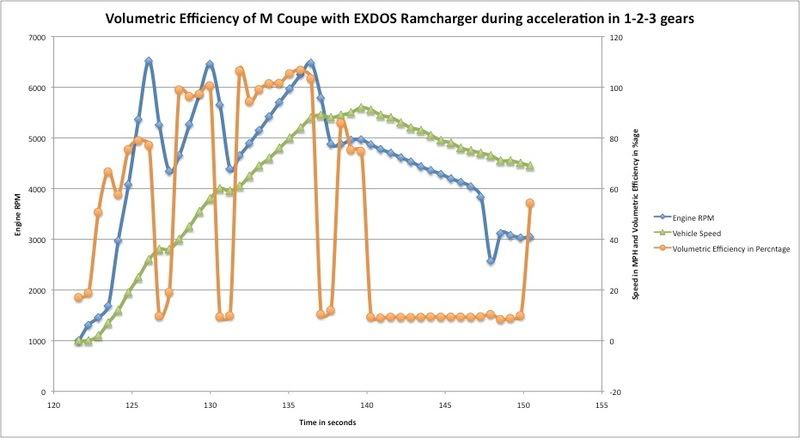 The graph below is prepared from the same data as the graph above, but I have removed the "spikes" to produce a "smoothed" representation of the change in Volumetric Efficiency with increase in speed. From this data, it appears that a Volumetric Efficiency of around 110%-115% might be attainable at the speed limit of 155mph.  I would therefore suggest that the E90 M3 air intake will be working extremely well in OEM format. |
|
Appreciate
0
|
| 11-02-2008, 04:31 PM | #35 | |
|
NASA/PDA Instructor

24
Rep 284
Posts |
I absolutely love your post...that is exactly what we need.
The main differences, and they are not small ones, is that (1) we don't have a MAF...and (2) our airbox differs from yours by a large port that vents to our hood. Therefore, we cannot get the same "ram-effect" as one can with a "closed" airbox (like your MCoupe). I would love to know if the vent out the hood is just for circulation...keeping the box cooler...or if it does indeed "feed" the intake when load is high. That's the question, because if it is not needed above...say 50mph...I'll seal the vent out of the hood and turn the box into a real "ram" system. Or install a flapper that would feed the box when needed, but stay closed and provide pressure at speed.... I just need the time/energy to do this... Quote:
__________________
 "Arcadian, I've fought countless times, yet I've never met an adversary who could offer me what we Spartans call "A Beautiful Death." I can only hope, with all the world's warriors gathered against us, there might be one down there who's up to the task."Μολὼν λαβέ!! |
|
|
Appreciate
0
|
| 11-03-2008, 07:25 AM | #36 |
|
Second Lieutenant
 
6
Rep 222
Posts |
Hi,
I'm glad you liked my post. I'll address both of the main differences between our cars that you've identified: 1. I see that your car has two MAP sensors instead of a MAF. This should prove to be no problem to a datalogger like my DashDynoSPD, because it should be able to receive information from at least one, if not both, of the MAPs. The figures that you will obtain will be in the same format for air-flow (lbs/min or gm/sec), as from a MAF, so you would still be able to calculate Volumetric Efficiency (VE) from the data logged. 2. Although there is a very significant physical difference between the air intake of your E90 M3 and my Z3 M Coupe (S54 version), in essence (function), they are pretty much the same layout. The Z3 MC's air intake is NOT sealed. There is a snorkel in the left "brake duct" in the bumper, BUT, there is also an opening behind the headlamp that must function similarly to the two ports that vent from your hood. Not only do I have a datalogger, I also have a Dwyer Magnehelic pressure gauge http://www.dwyer-inst.com/Products/P...fm?Group_ID=26 which is a very accurate measuring device to detect air pressure differentials. You can pick these up on ebay for very little money see: http://shop.ebay.com/?_from=R40&_npm...All-Categories If you decide to buy one, get one which has a range of around 6 inches of water. The gauge has three ports, to which you can attach some flexible tubing (fish tank stuff) and from these ports you can pass 5 or 6 metre length(s) of tubing(s) from the gauge mounted in your car to anywhere around the car (for aerodynamic measurements) or into your air intake system to see how your air-intake works. You can then record the air pressure changes under all the different driving scenarios to form a mental picture of what is happening under different scenarios: i.e cruising or Wide Open Throttle (WOT) at different speeds and in different gears. Below is a graph which I've made showing the theoretical increase in dynamic pressure (ram effect) on the black line and the pink line is the dynamic pressure at different speeds which I have measured with my Magnehelic pressure gauge. As you can see, my recordings are pretty close to the theoretical values. 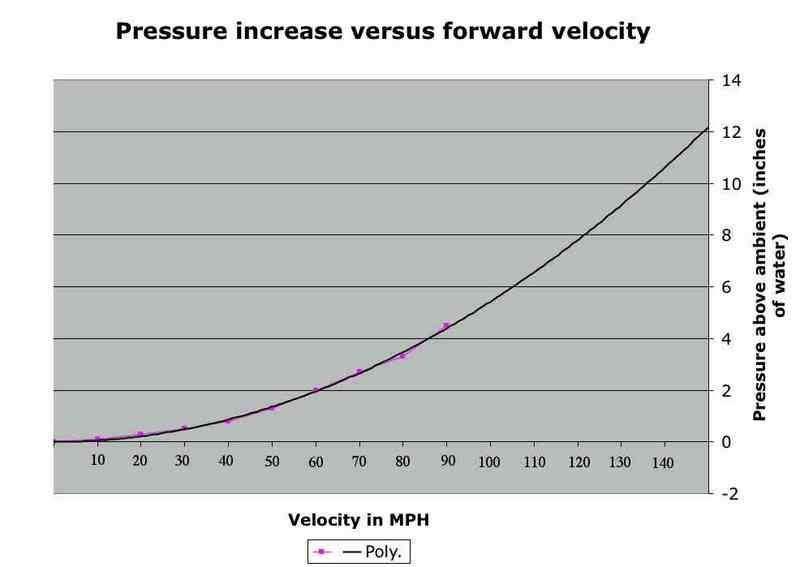 As you can see, I've recommended pressure gauge which can measure around 6 inches of water, the ram pressure at round 105mph, Since 1 atmosphere pressure (14.7lbs/square inch) equals 33.9 feet of water, and since 6 inches of water is less than a 1.5% increase in dynamic pressure most people who dismiss the possibility of ram effect being useful at relatively low speed (below 100mph+) use the 1.5% increase in dynamic pressure as being the reason to dismiss the possibility of ram-effect at low speed being useful. However, BMW engineers know better! MUCH BETTER. Take a look at the dyno print out below, which I found on a BMW car forum in this thread: http://www.e90post.com/forums/showthread.php?t=29831 Its for a E90 335 which appears to have a very similar air-intake to your E90 M3. This graph is typical of the shape of the plots for torque and horsepower measured on most static dynos.  In this graph you can see that peak torque occurs at around 3500rpm and then it falls away with increasing revs, this has the knock-on effect of reducing the maximum HP (work done) available . But if you look at the plot of the Air/Fuel ratio beneath, you can see why this happens: AIR STARVATION. Air starvation on many dynos, particularly with BMW's with ram-effect air intakes, occurs because the fans placed in front of the car on the static dyno, do NOT replicate the flow (pressure) of air passing in front of the car in "real world" on-the-road conditions, therefore, an engine with a ram-air intake system cannot replicate its true performance, when on a dyno when the wheels are turning at a speed greater than around 70-80mph if the power of the fan is insufficient to replicate air speed (pressure) at the same speed as the wheels are moving on the rollers. In comparison, take a look at a dyno graph below from data recorded by the DashDynoSPD of the performance of my MC in "real world" on-the-road conditions. The road I used when recording this data was level but a bit bumpy. 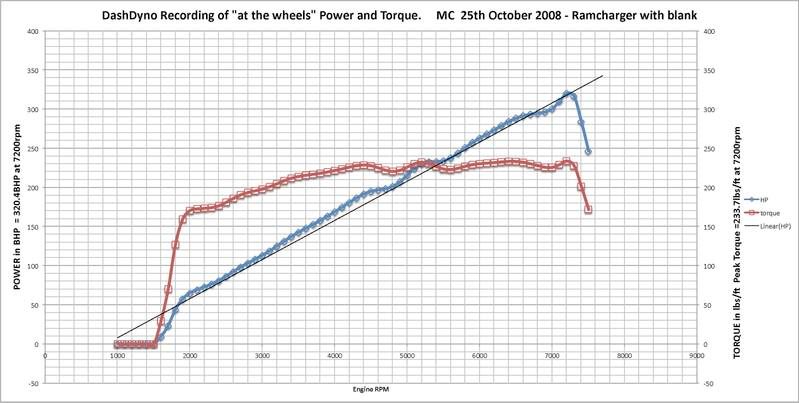 The car was driven at a steady 1500rpm on the cruise control in 3rd gear then the throttle was floored (WOT) and the car driven until the rev limiter kicked in. The drop off in values above 7000rpm is due to the relative slow data transfer speed of the ECU through the OBDII port on the Z3 MC. As you can see the torque plot shows a steady increase throughout the rev range (and in reality it does continue to the redline at 7600rpm). Obviously, air starvation does NOT occur in "real world" on-the-road conditions with a BMW ram-effect air-intake system. The Power output in my graph shows the "at the wheels" figure of 321bhp at 7200rpm, whereas, the published "at the flywheel" figure for the S54 engine in a Z3 MC is stated as producing 325bhp at 7600rpm, but this must be for an engine on a bench not benefitting from ram effect. For a S54 Z3 MC on a static dyno, the typical "at the wheels" horsepower is 275bhp, which is some 50bhp (15.38% losses) less than the "at the flywheel" figure. Therefore, the actual performance of my S54 engine in "real world" on-the-road conditions is producing an at the flywheel power output of around 375bhp, partly due to the benefits of the ram effect and my own air intake mods and also partly due to my "gutting" of the OEM silencers to make them "free-flowing". The accuracy of the figures produced by the DashDyno can be confirmed by dyno runs that my car performed 12 months ago on a dyno with a very powerful fan. Here's one of the plots below.  Unfortunately, the DSC kept bringing the rev limiter into play at 6600rpm, so that a a full run up to 7600rpm couldn't be made. However, as you can see, the car was still pulling all the way through the entire rev range (in 3rd gear) right up until the rev limiter cut in. As it happens, I experimented with covering the secondary air intake behind the headlamp on my MC, and I've prepared the graph below for you showing the difference in Volumetric Efficiency when the air intake is completely open and when partially closed off. 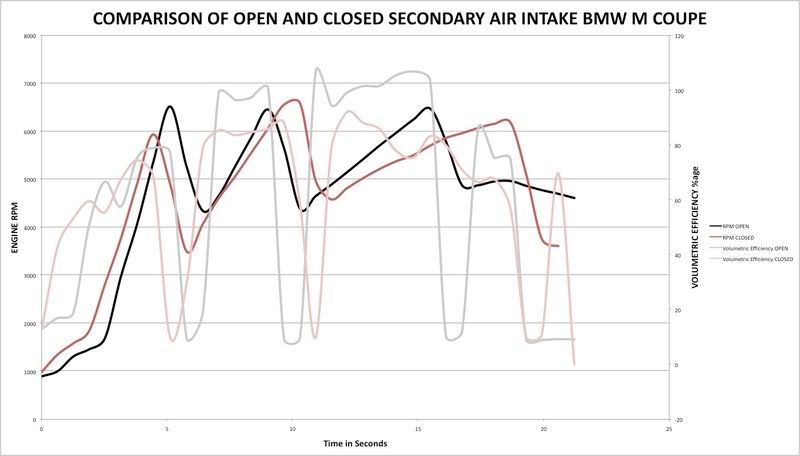 As you can see the VE barely gets above 90% when the air intake is partially blocked whereas the VE gets to 106% when it is OPEN as per OEM. These plots were performed on the same day and on the same run within five minutes of each other. I would therefore suggest that you should leave your air-intake completely OEM. Finally, the VE is constantly changing and being regulated by the throttle opening. The VE can only ever be at max when at WOT. It is under these circumstances when the air intake requires all the air that it can get, and this will be when your under-hood ports really come into use. When my MC is travelling at a steady 30mph under cruise control, the VE is between 9%-20%, only. At 38mph under cruise control, VE is between 24% -34%, only. At Idle the VE is between 12% -13%. I hope you find my data gives you a useful insight into what goes on inside your air-intake system. EDIT I've just done another graph from data that I recorded during a WOT acceleration right up to the the 7600rpm redline as below. 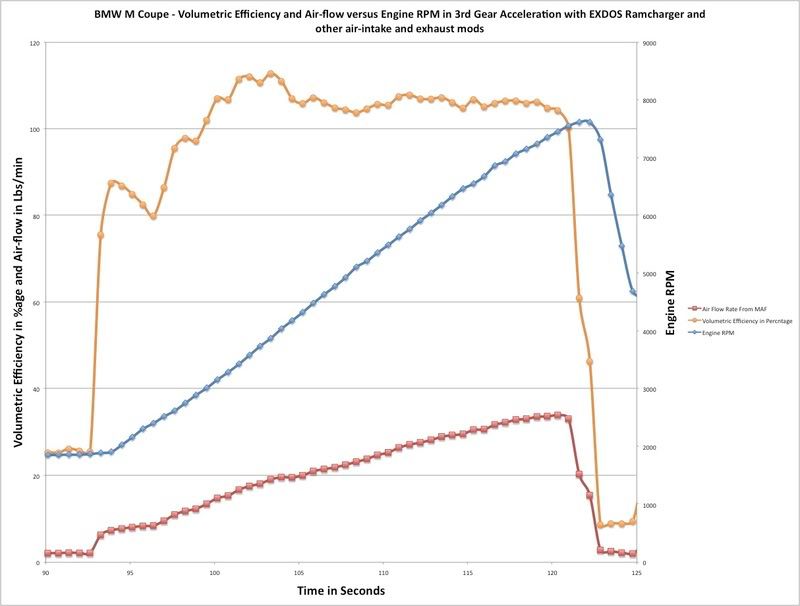 Once the car is travelling at above 3000rpm (60mph), the Volumetric Efficiency remains at over 100% proving that ram-effect does assist an engine to "breathe" at such low speeds and when dynamic air pressure has only increased by 2 inches of water - less than 0.5%! Last edited by exdos; 11-03-2008 at 02:59 PM.. |
|
Appreciate
0
|
| 11-03-2008, 07:40 AM | #37 | |
|
Major General
  
384
Rep 8,022
Posts |
Quote:
__________________
 Last edited by lucid; 11-03-2008 at 09:13 AM.. |
|
|
Appreciate
0
|
| 11-03-2008, 02:17 PM | #38 | |
|
Second Lieutenant
 
6
Rep 222
Posts |
Quote:
To do a Power/torque calculation you first need to set up a profile of the car, where you need the frontal area of the vehicle, weight, Cd, tyre diameter, gear ratio, air temperature, altitude and humidity. The DashDyno software then makes its calculations based on vehicle RPM sensor. The figures that are given are "at the wheels" and are corrected for all the variables of environment (altitude, temperature and humidity) so that the figures are "standardised" and thus comparable for the same vehicle driven in widely differing conditions. I have found the reproducibilty of the data on different runs to be very accurate and this works with all the different vehicles I've tested of varying performance types. I always get the environmental data from a local weather station via its minute-by-minute updates on the internet before and after I do dyno runs, to be sure that I'm logging the data as accurately as possible. The device is not a toy but a serious bit of equipment that also reads fault codes, so for me is a sound investment. |
|
|
Appreciate
0
|
| 11-03-2008, 02:49 PM | #39 | |
|
Major General
  
384
Rep 8,022
Posts |
Quote:
Using vehicle speed data and processing it in conjunction with rpm data can yield relevant outcomes if the vehicle model that is being used is comprehensive and valid. Is the tool you are using specific to BMWs? If it is a general OBDII tool, it shouldn't let you read/interpret BMW specific codes.
__________________
 |
|
|
Appreciate
0
|
| 11-03-2008, 03:06 PM | #40 | |
|
Second Lieutenant
 
6
Rep 222
Posts |
Quote:
I can only suggest that you try a DashDyno SPD for yourself with regards to reading BMW codes etc. I own other non-BMW vehicles besides the M Coupe. |
|
|
Appreciate
0
|
| 11-03-2008, 07:57 PM | #41 | |
|
Major General
  
384
Rep 8,022
Posts |
Quote:
I am only trying to understand if the devide is capable of reading BMW specific codes or not as I am looking for a such device, and if this does that, I might be interested in purchasing it. That's all.
__________________
 |
|
|
Appreciate
0
|
| 11-03-2008, 11:53 PM | #42 |
|
NASA/PDA Instructor

24
Rep 284
Posts |
dos,
Looks like a nice product. But the pressure sensor is what I need. I surmise that any "ram-air" scoop used will not enhance performance due to the large, it is quite big, vent that exits out the hood on the driver's side (the passenger vent is fake). During rain, or after a wash, water flies out that hole from air that is being rammed in the air-box from the two ram-intakes in the front of the car...our driver foglight area, and where these "scoops" go...the radiator location (which is much smaller than our foglight-inlet). My main thought, is that if the vent out the hood could be modded with a one-way valve, or flapper, or pivoting louvers (as another poster suggested), that we could have a true ram-airbox...but also allow air to be drawn in when there was a neutral or negative pressure inside the airbox dueto engine vacuum/load. That would allow a better 'ram-effect' at speed and not cause the VE to drop, as it did in your "blocking the headlamp inlet" experiment above on your MC. On my prior Ducati, I buzzed open the air inlets (a popular mod for the 996) to allow more air to be ingested at speed...but there was no opening in the airbox...it was sealed. Most motorcycle builders go to great lengths to have a sealed airbox, where ram-effect is maximized. If you have a hole in the box, the ram effect is not going to do much. I suspect that the hole in the hood is for when there isn't enough air being forced into the box at lower speeds and there is a drop in VE, as you saw in your experiment, because air was being "pulled" into the airbox...instead of being "pushed" from dynamic pressure. That's why, in my mad-scientist creative opinion, the flapper valve would allow both to happen but would allow an improvement in "ram-effect" by sealing the hood-vent when positive pressure/dynamic pressure was present in the airbox. Did I completely botch that explanation?..it's late... That's why I'd like the sensors...to see if the vent could be plugged or if it needs a one-way valve/flapper to allow the vent in the hood to be an inlet. If the third inlet shows a negative pressure at high load/rpm, then the flapper is needed...if not, then it can be closed. I'm not really concerned with the effects at anything under 50mph...I'd rather trade low-speed performance for high-speed (I do track my car) performance. But the flapper would accomplish both. The only other consideraton is the cooling effect of the circulated/dumped air out of the hood...but I'mnot concerned wth that...the airbox will be cool at speed anyway. Thank you for the suggestion, TomK
__________________
 "Arcadian, I've fought countless times, yet I've never met an adversary who could offer me what we Spartans call "A Beautiful Death." I can only hope, with all the world's warriors gathered against us, there might be one down there who's up to the task."Μολὼν λαβέ!! Last edited by ace996; 11-04-2008 at 12:13 AM.. |
|
Appreciate
0
|
| 11-04-2008, 02:17 AM | #43 |
|
Lieutenant General
   
638
Rep 10,404
Posts |
Very nice stuff exdos. I am thrilled to see another pro-science, pro-experimentation, pro-do it yourselfer kind of fellow posting here on the forum. We need more like you!
The spikes you refer to (that you smooth over in some plots) are simply the drops in rpm during shifts, correct? Just wanted to add that I think you might be missing something when referring to the 335 intake system as being similar to the M3. The M3 looks like this, which I have never seen anything quite like on a BMW. Cheers and welcome to the forum. |
|
Appreciate
0
|
| 11-04-2008, 06:36 AM | #44 |
|
Second Lieutenant
 
6
Rep 222
Posts |
Ace996,
I see what you are saying but I doubt if your idea will really benefit performance. I think the selection of graphs and data that I've posted actually show how an engine can and does benefit from a ram air-intake which is not an entirely closed system. As I said earlier, "The VE can only ever be at max when at WOT". The whole point of the throttle is that it acts as a REGULATOR to the amount of air that enters the cylinders on each stroke, to maintain a steady cruising speed below Vmax, the charge of air/fuel entering the cylinder on each stroke only needs to be a percentage less than Max. As I stated before: "When my MC is travelling at a steady 30mph under cruise control, the VE is between 9%-20%, only. At 38mph under cruise control, VE is between 24% -34%, only. At Idle the VE is between 12% -13%". If ram pressure in the air-intake is forcing a greater volume of air into the cylinders with each stroke, then to maintain your steady speed you need a lighter touch on the throttle otherwise the car will always accelerate with any throttle opening. At less than WOT, an effective ram-air intake is just making engine breathing easier and consequently more efficient. In all driving scenarios which require less than WOT, even at 99% WOT, it is the throttle which is acting as the regulator to air intake into the engine and any build up of excess air under ram pressure before the throttle which cannot be used will be eventually vented in some way or other, even if only by overflowing out of the air intakes; like a bath which is overflowing when the taps are left running. This can easily be demonstrated with a Magnehelic pressure gauge with the end of the pilot tube placed inside the air filter box: when you lift your foot off the accelerator the pressure inside the system goes up to almost the theoretical value for ram pressure at the vehicle speed as shown in the graph I've posted above entitled "Pressure increase versus forwards velocity". Looking at the diagram of the M3's air intake as posted by Swamp2, ALL the air intakes are sited in zones of positive pressure on a moving vehicle. See this article here: http://www.autospeed.com/cms/A_2162/article.html Therefore on your M3, when ask for WOT, the engine will be receiving air from zones of positive air pressure. What more can you ask for? Personally, I think your OEM air intake is an outstanding design. I'd love to be able to take some pressure readings and datalogging from one! I bet it achieves well over 100% VE. |
|
Appreciate
0
|
Post Reply |
| Bookmarks |
|
|